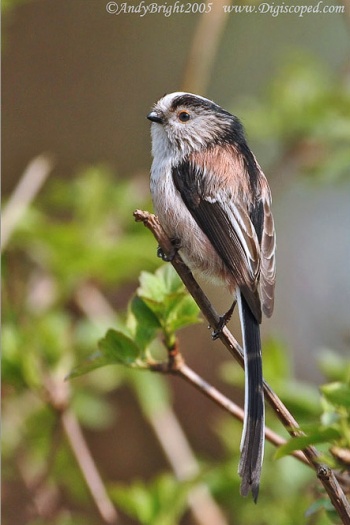(Flight photo added) |
(Video link) |
||
| Line 54: | Line 54: | ||
==External Links== | ==External Links== | ||
{{GSearch|Aegithalos+caudatus}} | {{GSearch|Aegithalos+caudatus}} | ||
| − | [[Category:Birds]][[Category:Aegithalos]][[Category:Bird Songs]] | + | <br /> |
| + | {{Video|Long-tailed_Tit}} | ||
| + | |||
| + | [[Category:Birds]][[Category:Aegithalos]][[Category:Bird Songs]] [[Category:Videos]] | ||
Revision as of 16:44, 31 March 2011
Alternative name: Long-tailed Bushtit
- Aegithalos caudatus
Includes: Silver-throated Tit
Identification
Very often will give the impression of a small fluffy circular ball with a long tail attached. Approximately 14 cm (5.5 inches) of which more than half constitutes its tail. Black and rosy-beige above and white below, with rosy-beige flanks. It has a white crown but populations differs in amount of black in head. Bill is very short.
Juvenile/immature is darker and less glossy, lack rosy colors, and right after fledging, the tail is shorter.
Distribution
Europe and Asia but not in tropical areas.
Taxonomy
Vinaceus and glaucogularis from China are sometimes considered a full species, Silver-throated Tit (Aegithalos glaucogularis).
Subspecies[1]
Nineteen to twentytwo subspecies are recognized by different authors:
- A. c. rosaceus: :British Isles
- A. c. caudatus: Scandinavia and north-eastern Europe to Siberia, northern China, Korea and Japan
- A. c. aremoricus: Western France, Channel Islands and Île d'Yeu
- A. c. taiti: Southern and south-western France to north-western Spain and Portugal
- A. c. irbii: Southern Spain, Portugal and Corsica
- A. c. europaeus: France and Germany to northern Italy, western Romania and northern Bulgaria
- A. c. italiae: Mainland Italy and Yugoslavia
- A. c. siculus: Sicily
- A. c. macedonicus: Albania, Yugoslavia, Greece and southern Bulgaria
- A. c. tauricus: Southern Crimean Peninsula
- A. c. tephronotus: Asia Minor
- A. c. major: Caucasus to western and central Transcaucasia
- A. c. alpinus: South-eastern Azerbaijan to northern Iran and south-western Turkmenistan
- A. c. passekii: Zagros Mountains (sw Iran)
- A. c. glaucogularis: Central China (mountains of western Sichuan to Yangtze delta)
- A. c. vinaceus: Northern and western China (Liaoning to Gansu, Qinghai and northern Yunnan)
- A. c. magnus: Southern Korea and Tsushima Island (Kamino-shima and Shimono-shima)
- A. c. trivirgatus: Japan (Honshu, Awa-shima, Sado and Oki); Cheju-Do Island (Korea)
- A. c. kiusiuensis: Southern Japanese islands (Shikoku, Kyushu and Yakushima)
Habitat
Deciduous woodlands with undergrowth.
Also wetland reed beds
Behaviour
Flight
Flight is short, whirring bursts and drops. Looks like a bouncing ball of fluff with a tail. Usually in flocks playing follow-my-leader from one patch of cover to another.
Seldom stays still for long, flitting about within a bush, chasing insects.
Breeding
Woven nests containing spider webs and lichen are built in a tree or shrub. Up to a dozen eggs per litter.
Diet
Diet includes insects
Vocalisation
<flashmp3>Aegithalos caudatus (song).mp3</flashmp3>
Listen in an external program
References
- Clements, JF. 2008. The Clements Checklist of Birds of the World. 6th ed., with updates to December 2008. Ithaca: Cornell Univ. Press. ISBN 978-0801445019.
- Wikipedia
- Beaman, M., S. Madge, K.M. Olsen. 1998. Fuglene i Europa, Nordafrika og Mellemøsten. Copenhagen, Denmark: Gads Forlag, ISBN 87-12-02276-4
External Links






